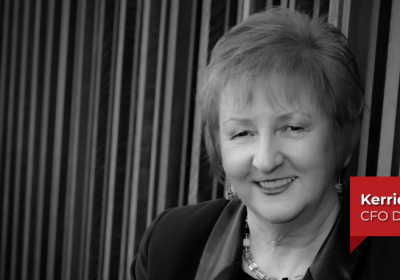
- Author: Jessica Mudditt
- Posted: September 29, 2022
Hit the ground running
Seasoned CFO Jenni Pilcher sets herself up for success by cultivating strong working relationships with the CEO and investors.
When Jenni Pilcher joined tech company Whispir as its CFO last November, one of the first tasks she set herself was to develop a strong rapport with the company’s CEO. Whispir was co-founded in 2001 by its current CEO, Jeromy Wells, who has led the company through a rapid growth trajectory.
“For my role to be successful, we need to be in sync,” says Pilcher. “It was important to me to make a good impression.”
To Pilcher, an excellent working relationship is built on trust. As a CFO, she believes that trust is gained by demonstrating extensive knowledge and capabilities. However, she believes that success is about more than being across the numbers.
“You have to understand the vision for the company, particularly when it is a founder-CEO and the company is their ‘baby’,” she explains. “It is important that you understand where the CEO is coming from, because it’s your job to help guide them to where they want to be.”
“You don’t always have to agree”
Inevitably, there will be differences of opinion as time goes on. Studies have found that CEOs are typically more optimistic and have a higher risk appetite than the average person, whereas a CFO is naturally more conservative and cost-focused. When debate is respectful, differences are a positive thing, says Pilcher.
“You don’t always have to agree. Healthy debate and challenging one another is good. I feel that Jeromy and I have a good balance: we’re respectful of each other’s opinions and our strengths and weaknesses are complementary, which makes the partnership stronger for the business than if it were the two of us working individually.”
Whispir is a Communication as a Service (CaaS) company whose cloud communications platform connects companies with their stakeholders in efficient ways – through automation. It listed on the ASX in 2019 and operates in Asia, Australia and North America.
Whispir has many government clients, including state health departments who used the platform to send out SMS message reminders for its COVID-19 vaccine programs. It is also used in many emergency response situations, for example, to send flood or fire warnings to local residents from local government emergency response teams. Whispir’s impressive client list includes Qantas, AusPost, BHP, Rio Tinto, Telstra and Foxtel. In March 2021, Whispir raised $45.3 million in capital in just 2.5 hours. It has rapidly grown its headcount and has made deep investments in product research and development.
“Whispir was a natural fit for me,” says Pilcher, who has held a total of four CFO roles since 2007. “I liked the growth path that it was on, and my specialty and experience is in high growth companies of a similar size. My experience was also well aligned to the global regions it’s operating in.”
Over the longer term, Pilcher is intent on supporting the company’s growth trajectory in new markets such as the United States, which is its largest addressable market.
“I want to help this business grow in a financially responsible way. And by growth, I mean both revenue growth and bottom-line growth,” she says.
Since Pilcher joined, she has overseen the creation of a new financial strategy to reach Earnings before interest and taxes (EBIT) positive this financial year, which is earlier than the previous target. On a more operational level, Pilcher has reset the finance function to make sure it has the right number of people with appropriate skillsets to support the business forward.
“We have implemented a cost efficiency program and have provided a line of sight to profitability for our investors, which may not have been as clear before,” she says.
Strong investor relations
Pilcher believes that building good relationships with investors is another critical measure of success in her role.
“It’s important to make yourself available to investors to build relationships. At the end of the day, they’re just people trying to do their job as well,” she says.
Knowing the numbers inside out and back to front is non-negotiable for a CFO, because it means that they can speak to investors with confidence. However, speaking plainly is paramount.
“It is okay to say, ‘Can I get back to you on that? I just need to do a bit more research.’ That’s a far better response than trying to give a vague answer that an astute investor would see right through,” she says.
She also sees it as an opportunity to further strengthen a relationship. Phoning the investor back provides a chance to develop one-on-one rapport.
Much like her approach to working with a CEO, Pilcher emphasizes the importance of understanding the perspective of individual investors. This requires excellent communication skills.
“One of the challenges is trying to understand where the investors are coming from, because everyone thinks differently and they may have different ways of calculating a financial metric. They don’t necessarily have all the information that you have. They might be trying to do back- of-the-envelope calculations on where they expect revenue to be, for example.”
Her advice is to try to make sure that investors are focused on the right metrics. A CFO who can follow an investors’ logic can explain other factors that may need to be taken into account. Then everyone is on the same page.
“Don’t gloss over things”
It is also important to speak the same language as an investor. Take more of a high-level approach and try to avoid getting into the nitty gritty of specific calculations.
“It is important to be able to articulate the numbers to an investor, who may operate at more of a high level than you. Make sure that you know the talking points. What is your revenue? What are your gross margins? What are your costs this quarter versus last quarter?”
With Whispir going from strength to strength, these conversations are upbeat and positive. She relishes the opportunity to deliver shareholder value and to see share prices climbing. However, she knows from past experience that when things are not going as well, it can be really challenging – and that is where having a good relationship can help. “Don’t try and gloss over things. It is what it is. Explain what is being done to address the difficulties and what the potential is going forward. Paint the picture for the next 12 and 24 months and try and get them on that journey with you.”








